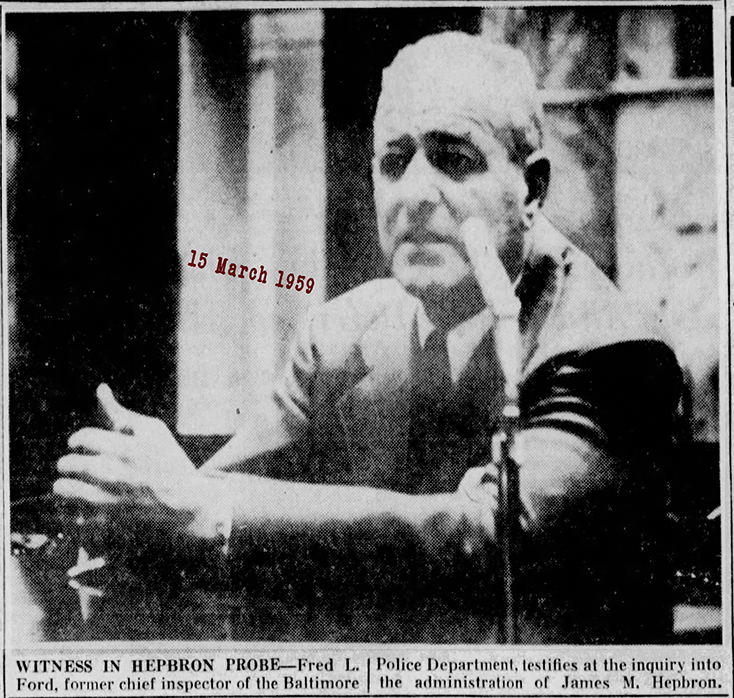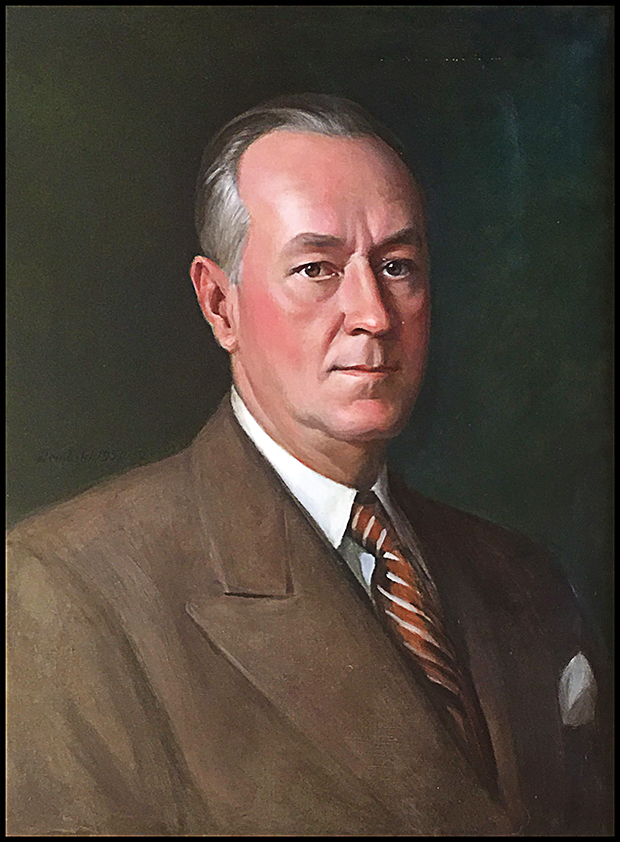 Police Commissioner James M. Hepbron
Police Commissioner James M. Hepbron
1955 until 1961
Painting by Stanislav Rembski

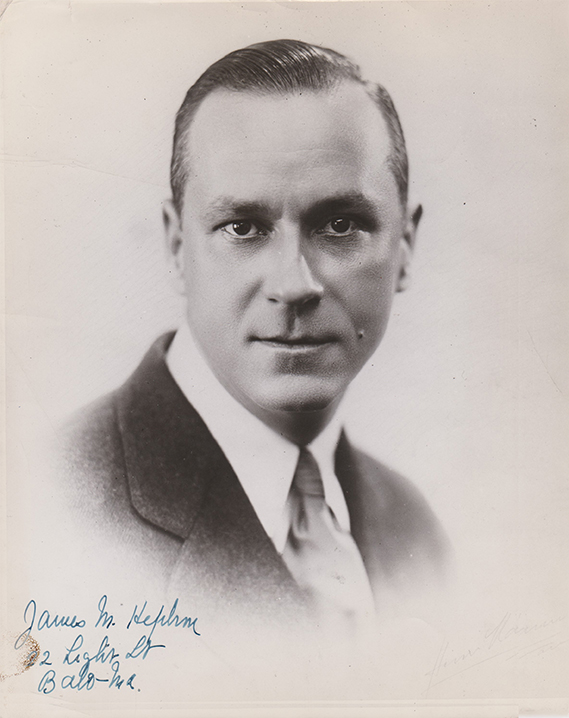 James M. Hepbron
James M. Hepbron
 One of The American City’s first reports on police dogs appeared in an October 1957 article by James Hepbron, Baltimore’s police commissioner. According to the article, the idea for adding the dogs to the police force came from residents who read a 1956 newspaper series about Scotland Yard’s police dogs in London. A veteran of the U.S. Marine’s K-9 Corps volunteered to start the city’s training program, and one man offered the use of his German shepherd. Soon, a patrolman donated a second dog and asked to be assigned to the corps. The department expanded the K-9 unit with six more donated dogs in January 1957. In their first year, Baltimore’s police dogs participated in 175 arrests, and “almost daily, police officers report that fugitives immediately give up any idea of fleeing at the sight of a dog.”
One of The American City’s first reports on police dogs appeared in an October 1957 article by James Hepbron, Baltimore’s police commissioner. According to the article, the idea for adding the dogs to the police force came from residents who read a 1956 newspaper series about Scotland Yard’s police dogs in London. A veteran of the U.S. Marine’s K-9 Corps volunteered to start the city’s training program, and one man offered the use of his German shepherd. Soon, a patrolman donated a second dog and asked to be assigned to the corps. The department expanded the K-9 unit with six more donated dogs in January 1957. In their first year, Baltimore’s police dogs participated in 175 arrests, and “almost daily, police officers report that fugitives immediately give up any idea of fleeing at the sight of a dog.”
Two years later, Baltimore’s K-9 Corps included 21 trained dogs, according to a November 1959 American City report. The officers that worked with the dogs had to volunteer for the job and were charged with caring for the dogs at all times. The department required that its dogs were male German shepherds with an even temperament. They were trained first in obedience, then in attack work, and then to locate lost persons, criminals, and evidence.
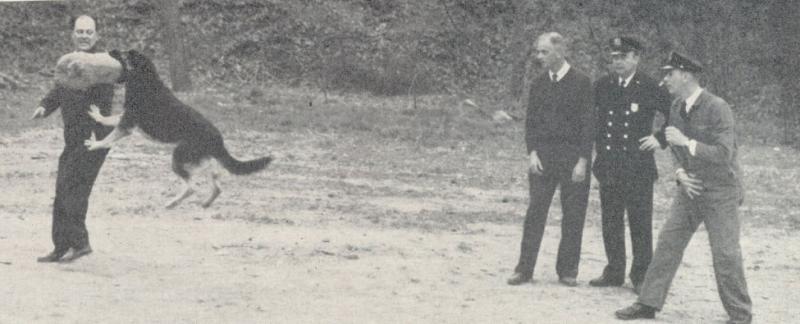
Word of Baltimore’s successful experiences with police dogs soon spread, and the department trained other departments to establish their own K-9 units. The May 1962 edition carried a report on Lancaster, Pa.’s decision to start a K-9 Corps after officers visited Baltimore in 1959. Lancaster modeled its unit after Baltimore, asking residents to donate dogs to the corps and selecting six handlers from among police volunteers. The Baltimore Police Department trained one of Lancaster’s officers, who then trained the five additional handlers. They built obstacles and trained the dogs to climb ramps, crawl through pipes and jump barriers. Lancaster officers soon discovered that not every donated dog would be suited for police work. One of its early lessons: “A dog, to be effective in police work, must be a ‘people-biter.’”

On February 19, 1959, Commissioner James M. Hepbron was the subject of a hearing under the direction of Jerome Robinson, the Democratic State Delegate for the fourth district. Delegate Robinson had a long history of challenging wiretapping and search warrants, as he believed the practice was unconstitutional, against federal law, and a violation of the natural rights of the citizen. In the 90-day public hearing and investigation, Robinson stated that the commissioner "demonstrated a lack of a sense of propriety and, in several respects, a lack of comprehension on the part of the commissioner of the nature of his duties, the functions of the department, and the obligations to the citizenry." During the public hearing, Hepbron incessantly left the hearing and/or refused to answer specifications against him.
During the hearing, Robinson urged the commissioner to resign in the public interest. Robinson wrote, "It is obvious that he has outlived his position. His administration has produced continuing deterioration and the demoralization of the department.
The charges against Hepbron included:
- Flouting of the civil and constitutional rights of the citizens of Baltimore City. Illegal taps of private and public telephone lines
- Errors in judgment and administration
- Concepts of policing, because of their brutality and insentivity, are shocking to decent-minded people.
Despite considerable evidence, Hebron denied that he was acting illegally. Delegate Robinson cited 36 cases where the cases were dropped or defendants released because of planted evidence and other means of framing suspects. He called these offenses "a creature of Commissioner Hepbron." Robinson also cited the Green Spring Avenue assault by a police officer of a 15-year-old boy, countless shootings of unarmed auto-thieves, and illegal raids on properly licensed establishments. At one point, Robinson stated the head of the city police was "an SS officer in a Chesterfield coat who is impatient with the Bill of Rights and intolerant of the constitutional liberties and prerogatives of the people."
Alvin J. T. Zumbrun, former managing director of the Criminal Justice Commission, issued a statement against Robinson in the commissioner's defense. He described the charges brought against Hepbron "the utterances of an angry madman possessed with the mania to have the police commissioner removed at all costs." Zumbrun cited details of multiple instances where he believed Robinson had lied, citing instances as small as a phone call, an office visit, or an informal greeting by Robinson to Zumbrun. While Zumbrun's evidence never addressed actual police violations of state law, Zumbrun continued to press for the expulsion of Robinson of the General Assembly of Maryland to Governor J. Millard Tawes
James Hepbron's Book on the Penal System is HERE

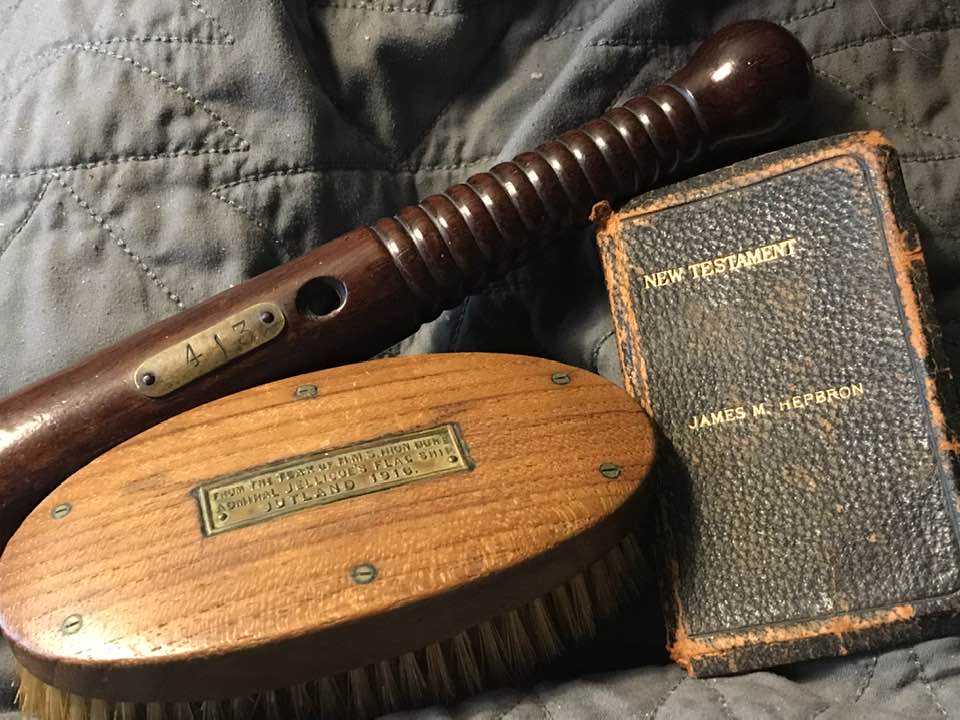
A friend of Commissioner James Hepbron's family gave these items to us.
Take note of the brass plate with the number 413 that is fastened to the former commissioner's Billy Club. Knowing Hepbron to be somewhat of a maticulouse thinker, we speculated about the meaning of 413 based on the way he thought. We immediately looked up Philippians 4:13 in the New King James Version of the Bible to see what it might mean because he was also carrying thewell-used New Testament with his name inscribed on it, as seen in the photo above. We discovered that it says,
"I can do all things through Christ, who strengthens me."
Although we cannot be certain, if not, it was a happy coincidence that complemented his Christian beliefs.
Click HERE or Article above for full size story
Click HERE or Article above for full size story

Donations
Donations help with web hosting, stamps and materials, and the cost of keeping the website online. Thank you so much for helping BCPH.


POLICE INFORMATION
If you have copies of: your Baltimore Police Department class photo, pictures of our officers, vehicles, equipment, newspaper articles relating to our department and/or officers, old departmental newsletters, lookouts, wanted posters, or brochures Information on deceased officers and anything that may help preserve the history and proud traditions of this agency Please contact retired detective Kenny Driscoll.
This email address is being protected from spambots. You need JavaScript enabled to view it.

NOTICE
How to Dispose of Old Police Items
Please contact Det. Ret. Kenny Driscoll if you have any pictures of you or your family members and wish them remembered here on this tribute site to Honor the fine men and women who have served with Honor and Distinction at the Baltimore Police Department. Anyone with information, photographs, memorabilia, or other "Baltimore City Police" items can contact Ret. Det. Kenny Driscoll at This email address is being protected from spambots. You need JavaScript enabled to view it. follow us on Twitter @BaltoPoliceHist or like us on Facebook or mail pics to 8138 Dundalk Ave. Baltimore Md. 21222
Copyright © 2002 Baltimore City Police History: Ret Det. Kenny Driscoll





 One of The American City’s first reports on police dogs appeared in an October 1957 article by James Hepbron, Baltimore’s police commissioner. According to the article, the idea for adding the dogs to the police force came from residents who read a 1956 newspaper series about Scotland Yard’s police dogs in London. A veteran of the U.S. Marine’s K-9 Corps volunteered to start the city’s training program, and one man offered the use of his German shepherd. Soon, a patrolman donated a second dog and asked to be assigned to the corps. The department expanded the K-9 unit with six more donated dogs in January 1957. In their first year, Baltimore’s police dogs participated in 175 arrests, and “almost daily, police officers report that fugitives immediately give up any idea of fleeing at the sight of a dog.”
One of The American City’s first reports on police dogs appeared in an October 1957 article by James Hepbron, Baltimore’s police commissioner. According to the article, the idea for adding the dogs to the police force came from residents who read a 1956 newspaper series about Scotland Yard’s police dogs in London. A veteran of the U.S. Marine’s K-9 Corps volunteered to start the city’s training program, and one man offered the use of his German shepherd. Soon, a patrolman donated a second dog and asked to be assigned to the corps. The department expanded the K-9 unit with six more donated dogs in January 1957. In their first year, Baltimore’s police dogs participated in 175 arrests, and “almost daily, police officers report that fugitives immediately give up any idea of fleeing at the sight of a dog.”




